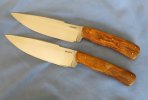- Joined
- Apr 13, 2017
- Messages
- 2,115
A customer sent me some mammoth tusk and said "make me a pair of knives". There were a fair amount of delams, cracks and voids which I understood is not out of the ordinary and I filled these carefully with thin CA or dyed epoxy mixed with fine sanding dust.
I spent a lot of time with the custom search engine which had boatloads of info and lots about the final finish. But most of it was very old from the early 2000's to 2012 or so and included soaking in a variety of mineral and baby oils for 24-48 hrs, just this or that wax, both and all kinds of things. Also saw soaking for maintenance once or twice a year.
So I was wondering what the current thinking is? Right now they are hand sanded to 1200 and 2000 grit respectively and dyed with blended fiebrings colors.

He also sent me a piece with great green/camo bark that's going on a B&T/EDC.
I spent a lot of time with the custom search engine which had boatloads of info and lots about the final finish. But most of it was very old from the early 2000's to 2012 or so and included soaking in a variety of mineral and baby oils for 24-48 hrs, just this or that wax, both and all kinds of things. Also saw soaking for maintenance once or twice a year.
So I was wondering what the current thinking is? Right now they are hand sanded to 1200 and 2000 grit respectively and dyed with blended fiebrings colors.

He also sent me a piece with great green/camo bark that's going on a B&T/EDC.
